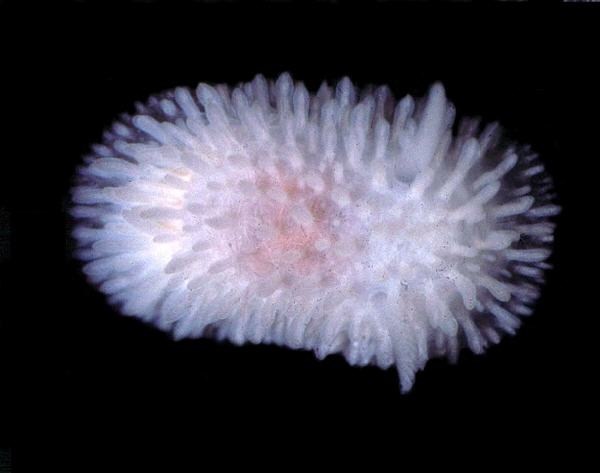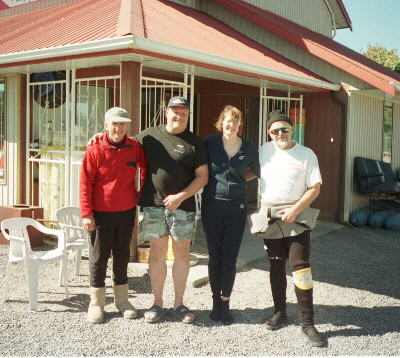 |
Adalaria proxima
Photo by Dave Nesheim taken near Nanaimo, British Columbia, September, 1999
Adalaria proxima (Alder & Hancock, 1854)
I always find it fascinating when the same boreal species occurs in both the Pacific and Atlantic Oceans but has not been found between Iceland and the Gulf of Alaska. Are they now separated by the inhospitable waters of the Arctic Ocean or are there pockets of invertebrate richness found here and there in the Arctic? Is there any gene flow remaining or have they been isolated since the opening of the Bering land bridge in the late Pliocene (3.5-4mya): an event that caused a major exchange of boreal fauna from the Pacific to the Atlantic? At present it remains a mystery why so many opisthobranch species have a disjunct distribution between the northern Pacific and both sides of the Atlantic. Our nudibranch of the week, Adalaria proxima, is one of these. Others are: Cylichna alba, Alderia modesta, Placidia dendritica, Acanthodoris pilosa, Aeolidia papillosa, Cuthona concinna, Cuthona pustulosa, Cuthona viridis, Dendronotus frondosus, Flabellina verrucosa, Onchidoris bilamellata, Onchidoris muricata and probably Ancula gibbosa.
Adalaria proxima reaches a size of 2.5 cm and can be distinguished from Adalaria jannae by its larger size, longer, more slender tubercles and lack of a round, post-branchial knob. The tubercles can vary in their amount of inflation, but always have pointed tips and are larger than those of A. jannae. At the bases of the tubercles, spicules form a conspicuous star-like pattern in the mantle. This species is usually white, but can be pale yellow. The white spawn mass forms a smooth coil. On the Pacific coast, animals spawn in early spring (Feb.- April) although there is occasionally a second spawning from July to October.
The radula has 35-50 rows of teeth with the formula (8-15.1.1.1.8-15). The central tooth is a rectangular plate. The large first lateral teeth have a few fine denticles in juveniles under 10 mm, but none in adults. The marginal teeth are plate like. Adalaria proxima feeds on a variety of encrusting bryozoans growing on kelp, Membranipora being the most common one eaten locally. It is found from the intertidal to the shallow subtidal and ranges from England north to Norway and into the Baltic Sea. It is found across the Atlantic (Faroes, Iceland and Greenland) and down the eastern seaboard to Massachusetts. In the Pacific Ocean, this species is found from the Bering Sea to southern British Columbia.
Adalaria proxima has been well studied in Great Britain. The morphology and life history have been studied by Thompson (1958, a,b,c) and the reproductive strategies and energetics by Todd (1979), Todd & Havenhand (1985, 1988, 1989) and Havenhand & Todd (1988a, 1988b).
References:
Millen, Sandra. 1987. The nudibranch genus Adalaria with a description of a new species from the northeastern Pacific. Can. J. Zool. 65: 2696-2702.
Thompson, T.E., 1958a. Observations on the radula of Adalaria proxima (Alder & Hancock) (Gastropoda, Nudibranchia). Proc. Malac. Soc. Lond. 33:49-56.
Thompson, T.E., 1958b. The natural history, embryology, larval biology and post-larval development of Adalaria proxima. Phil. Trans. R. Soc. Ser. B 242: 1-58.
Thompson, T.E. 1958c. The influence of temperature on spawning of Adalaria proxima (A.& H.) (Gastropoda, Nudibranchia). Oikos 9:246-252.
Todd, C.D. 1979. Reproductive energetics of two species of dorid nudibranchs with planktotrophic and lecithotrophic larval strategies. Marine Biology 53: 57-68.
Todd, C.D. & J. N. Havenhand, 1988. Physiological ecology of Adalaria proxima (Alder et Hancock) and Onchidoris muricata (Muller) (Gastropoda: Nudibranchia). III. Energy budgets. J. Exp. Mar. Biol. Ecol., 118: 191-205.
Todd, C.D. & J. N. Havenhand, 1989. Nudibranch-bryozoan associations: the quantification of ingestion and some observations on partial predation among doridoidea. J. Moll. Stud. 55: 245-259.
Havenhand, J. N. & C.D. Todd. 1988a. Physiological ecology of Adalaria proxima (Alder et Hancock) and Onchidoris muricata (Muller) (Gastropoda: Nudibranchia). I. Feeding, growth, and respiration. J. Exp. Mar. Biol. Ecol. 118: 151-172.
Havenhand, J. N. & C.D. Todd. 1988b. Physiological ecology of Adalaria proxima (Alder et Hancock) and Onchidoris muricata (Muller) (Gastropoda:Nudibranchia). II. Reproduction. J. Exp. Mar. Biol. Ecol. 118: 173-189.

|
Sandra MillenDepartment of ZoologyUniversity of British Columbia Vancouver, B.C., Canada, V6T 1Z4 Phone (604) 822-2087; Fax (604) 822-2416 Send Sandra E-Mail at millen@zoology.ubc.ca or visit Sandra's home page Sandra is pictured at third from left along with Dave Nesheim (LAUPS), Alan Grant (aka the diving dentist), and Mike Miller (webmaster) taking a break between dives at Nanaimo, British Columbia during a field trip to British Columbia in September of last year. We flew up to Seattle, rented a car and continued up into Canada. We didn't see the number of branchs encountered during our '98 trip report, but nevertheless were able to get spectacular video and still footage of what we did see. And of course, diving Dodd's Narrows is always a must when in the Nanaimo area. We were very happy with our boat skipper Rod and the whole Ocean Explorers Diving operation. |
